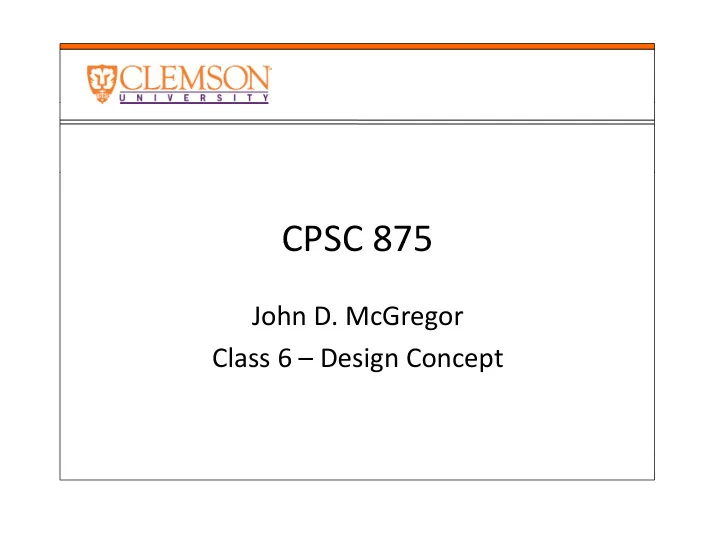

CPSC 875 CPSC 875 John D McGregor John D. McGregor Class 6 – Design Concept
Unix Unix
Linux Linux
Android Android
VxWorks/Windows VxWorks/Windows
• We have requirements We have requirements • We have identified a starting point
Step 3: Identify Candidate Architectural Drivers • Choose the top level qualities using the Choose the top level qualities using the scenarios • 12 was #1 • 12 was #1 Source: Vehicle collision warning system Stimulus: Driver's vehicle is about to collide with another object Artifact: Forward facing radar and collision prediction system Environment: Normal operation Response: Warn driver; apply brakes; close all windows; tighten seatbelts; adjust peoples’ positions Response Measure: Response should occur less than .5 seconds after the conditions for a potential collision are detected • Quality attributes – time efficiency; reliability
#2 #2 Source ‐ driver Source driver Stimulus ‐ hit deer Artifact ‐ emergency response system Artifact emergency response system Environment ‐ collision Response system notifies police; deploys air bags Response ‐ system notifies police; deploys air bags RespMeasure ‐ 1/2 second Qualities ‐
#9 #9 Source: Vehicle Stimulus: Comes in the close proximity of another vehicle or vehicles Artifact: Collision Prevention System Environment: Normal Response: Notify vehicles that will be affected and accordinly Response: Notify vehicles that will be affected and accordinly accelerate or de ‐ accelerate. Response Measure: 0.3 seconds p Qualities Qualities ‐
Quality attributes Quality attributes IEEE Std. 1061 subfactors: • Efficiency Portability • Time economy • Hardware independence • Resource economy • Software independence Functionality Functionality • Installability Installability • Completeness • Reusability • Correctness Reliability • Security • Non ‐ deficiency • Compatibility C ibili • Error tolerance E l • Interoperability • Availability Maintainability Usability • Correctability y • Understandability y • Expandability • Ease of learning • Testability • Operability • Comunicativeness
Reliability Reliability • Software Reliability: P(A|B) Software Reliability: P(A|B) • A : Software does not fail when operated for t time units under specified conditions. • B : Software has not failed at time 0 • B : Software has not failed at time 0. • Ultra ‐ high reliability requirements for safety ‐ critical systems ( Draft Int’l Standard IEC65A123 for Safety Integrity Level 4 ) : systems ( Draft Int l Standard IEC65A123 for Safety Integrity Level 4 ) : • Continuous control systems: < 10 ‐ 8 failures per hour Airbus 320/330/340 and Boing 777: <10 ‐ 9 failures/h This translates to 113,155 years of operation without encountering Thi t l t t 113 155 f ti ith t t i a failure • Protection systems (emergency shutdown): < 10 ‐ 4 failures/h UK Seizewell B nuclear reactor (emerg ) <10 ‐ 3 failures/h UK Seizewell B nuclear reactor (emerg.): <10 ‐ 3 failures/h
What does it mean? What does it mean? R (for 1h mission time) Failure intensity 0 386 0.386 1 f il 1 failure/h /h 0.9 105 failures/1000h 0.959 1 failure/day 0 99 0.99 1 failure/100 h 1 failure/100 h 0.994 1 failure/week 0.9986 1 failure/month 0.999 1 failure/1000 h 0.99989 1 failure/year
Definitions Definitions • Error – an incorrect result; sometimes used to refer Error an incorrect result; sometimes used to refer to a mistake made during development • Fault – some errors are manifest in the artifacts of the system • Failure – when a fault is executed and the incorrect result is propagated to where it is visible
operational profile operational profile • We must know which operation are used the We must know which operation are used the most • We operate the program according to that • We operate the program according to that profile • Record failures R d f il • Do the math
• The robustness of software is related to how The robustness of software is related to how badly things go wrong when it fails to do exactly what it is supposed to do exactly what it is supposed to do • Reliability growth models
Design for reliability Design for reliability • Simplicity ‐ as complexity increases Simplicity as complexity increases, probability of faults being injected increases – Avoid designs that require dynamic allocation – Avoid designs that require dynamic allocation – Avoid designs that require reflection – … • Use mature technologies not fads • Why C++ and not C?
Styles and patterns Styles and patterns • An architecture style and a pattern are very An architecture style and a pattern are very similar • A pattern may have more information • A pattern may have more information, particularly more information about trade ‐ offs among attributes among attributes. • Which patterns enhance which qualities?
Fault Tolerance Fault Tolerance • We can have faults We can have faults • We can even execute the faults as long as the effect does not propagate effect does not propagate • • http://www.ijcaonline.org/volume18/number 2/pxc3872900.pdf
Voting pattern Voting pattern
Avoid bad habits Avoid bad habits • Stop writing lousy code Stop writing lousy code – http://cwe.mitre.org/ ‐ common weaknesses • Design for failure • Design for failure • Keep it Simple • Test… test… test…. • Get in the trenches with Ops p • Safety first http://www.javacodegeeks.com/2011/06/lessons-in-software-reliability.html
Time efficiency Time efficiency • Avoid context switches Avoid context switches – Function, thread, process • Concurrency • Concurrency • Parallelism
Recommend
More recommend